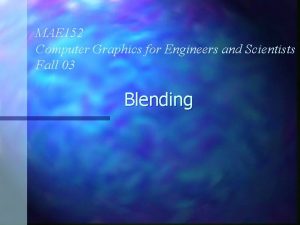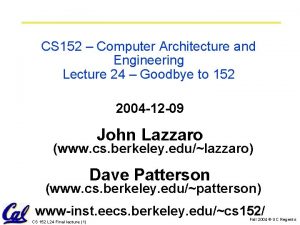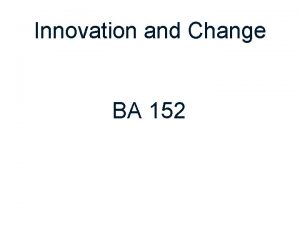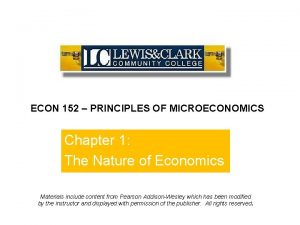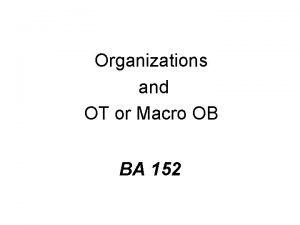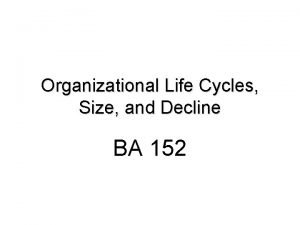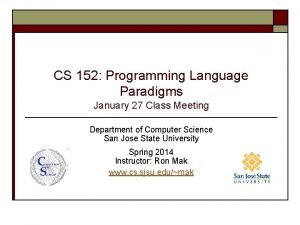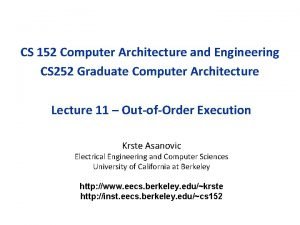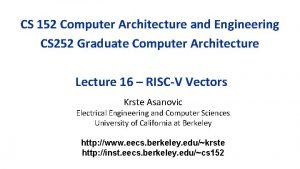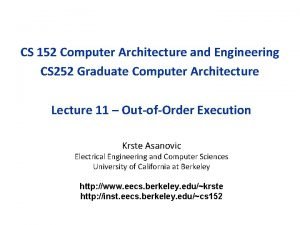CS 152 Computer Architecture and Engineering CS 252

















![Nonblocking Synchronization Compare&Swap(m), Rt, Rs: if (Rt==M[m]) then M[m]=Rs; Rs=Rt ; status success; else Nonblocking Synchronization Compare&Swap(m), Rt, Rs: if (Rt==M[m]) then M[m]=Rs; Rs=Rt ; status success; else](https://slidetodoc.com/presentation_image_h2/5ab2bf7208f49a18d5bce73c364caa80/image-18.jpg)





![Transactional Memory § Proposal from Knight [‘ 80 s], and Herlihy and Moss [’ Transactional Memory § Proposal from Knight [‘ 80 s], and Herlihy and Moss [’](https://slidetodoc.com/presentation_image_h2/5ab2bf7208f49a18d5bce73c364caa80/image-24.jpg)

- Slides: 25

CS 152 Computer Architecture and Engineering CS 252 Graduate Computer Architecture Lecture 20 Synchronization Krste Asanovic Electrical Engineering and Computer Sciences University of California at Berkeley http: //www. eecs. berkeley. edu/~krste http: //inst. eecs. berkeley. edu/~cs 152

Last Time in Lecture 19 § Memory Consistency Model (MCM) describes what values are legal for a load to return § Sequential Consistency is most intuitive model, but almost never implemented in actual hardware – Single global memory order where all individual thread memory operations appear in local program order § Stronger versus Weaker MCMs – TSO is strongest common model, allows local hardware thread to see own stores before other hardware threads, but otherwise no visible reordering – Weak multi-copy atomic model allows more reordering provided when a store is made visible to other threads, all threads can “see” at same time – Very weak non-multi-copy atomic model allows stores from one thread to be observed in different orders by remote threads § Fences are used to enforce orderings within local thread, suffice for TSO and weak memory models § Heavyweight barriers are needed for non-multi-copy atomic, across multiple hardware threads 2

Synchronization The need for synchronization arises whenever there are concurrent processes in a system (even in a uniprocessor system). producer Two classes of synchronization: § Producer-Consumer: A consumer process must wait until the producer process has produced data § Mutual Exclusion: Ensure that only one process uses a resource at a given time consumer P 1 P 2 Shared Resource 3

Simple Mutual-Exclusion Example Thread 1 xdatap data Thread 2 xdatap Memory // Both threads execute: ld xdata, (xdatap) add xdata, 1 sd xdata, (xdatap) Is this correct? 4

Mutual Exclusion Using Load/Store (assume SC) A protocol based on two shared variables c 1 and c 2. Initially, both c 1 and c 2 are 0 (not busy) Process 1. . . c 1=1; L: if c 2=1 then go to L < critical section> c 1=0; What is wrong? Process 2. . . c 2=1; L: if c 1=1 then go to L < critical section> c 2=0; Deadlock! 5

Mutual Exclusion: second attempt To avoid deadlock, let a process give up the reservation (i. e. Process 1 sets c 1 to 0) while waiting. Process 1. . . L: c 1=1; if c 2=1 then { c 1=0; go to L} < critical section> c 1=0 Process 2. . . L: c 2=1; if c 1=1 then { c 2=0; go to L} < critical section> c 2=0 • Deadlock is not possible but with a low probability a livelock may occur. • An unlucky process may never get to enter the critical section starvation 6

A Protocol for Mutual Exclusion T. Dekker, 1966 A protocol based on 3 shared variables c 1, c 2 and turn. Initially, both c 1 and c 2 are 0 (not busy) Process 1. . . c 1=1; turn = 1; L: if c 2=1 & turn=1 then go to L < critical section> c 1=0; Process 2. . . c 2=1; turn = 2; L: if c 1=1 & turn=2 then go to L < critical section> c 2=0; • turn = i ensures that only process i can wait • variables c 1 and c 2 ensure mutual exclusion Solution for n processes was given by Dijkstra and is quite tricky! 7

Scenario 1 . . . Process 1 c 1=1; turn = 1; L: if c 2=1 & turn=1 then go to L < critical section> c 1=0; . . . Process 2 c 2=1; turn = 2; L: if c 1=1 & turn=2 then go to L < critical section> c 2=0; Scenario 2 Analysis of Dekker’s Algorithm . . . Process 1 c 1=1; turn = 1; L: if c 2=1 & turn=1 then go to L < critical section> c 1=0; . . . Process 2 c 2=1; turn = 2; L: if c 1=1 & turn=2 then go to L < critical section> c 2=0; 8

ISA Support for Mutual-Exclusion Locks § Regular loads and stores in SC model (plus fences in weaker model) sufficient to implement mutual exclusion, but code is inefficient and complex § Therefore, atomic read-modify-write (RMW) instructions added to ISAs to support mutual exclusion § Many forms of atomic RMW instruction possible, some simple examples: – Test and set (reg_x = M[a]; M[a]=1) – Swap (reg_x=M[a]; M[a] = reg_y) 9

Lock for Mutual-Exclusion Example xlockp Thread 1 xdatap lock data xlockp Thread 2 xdatap Memory // Both threads execute: li xone, 1 spin: amoswap xlock, xone, (xlockp) bnez xlock, spin Acquire Lock ld xdata, (xdatap) add xdata, 1 Critical Section sd xdata, (xdatap) sd x 0, (xlockp) Release Lock Assumes SC memory model 10

Lock for Mutual-Exclusion with Relaxed MM xlockp Thread 1 xdatap lock data xlockp Thread 2 xdatap Memory // Both threads execute: li xone, 1 spin: amoswap xlock, xone, (xlockp) bnez xlock, spin fence r, rw ld xdata, (xdatap) add xdata, 1 sd xdata, (xdatap) fence rw, w sd x 0, (xlockp) Acquire Lock Critical Section Release Lock 11

CS 152 Administrivia § Midterm 2 in class Wednesday April 11 – covers lectures 10 -17, plus associated problem sets, labs, and readings § PS 5 out on Wednesday April 11 § Lab 5 in section on Friday April 13 12

CS 252 Administrivia § Monday April 9 th Project Checkpoint, 4 -5 pm, 405 Soda – Prepare 10 -minute presentation on current status CS 252 13

RISC-V Atomic Memory Operations § Atomic Memory Operations (AMOs) have two ordering bits: – Acquire (aq) – Release (rl) § If both clear, no additional ordering implied § If aq set, then AMO “happens before” any following loads or stores § If rl set, then AMO “happens after” any earlier loads or stores § If both aq and rl set, then AMO happens in program order 14

Lock for Mutual-Exclusion using RISC-V AMO xlockp Thread 1 xdatap lock data xlockp Thread 2 xdatap Memory // Both threads execute: li xone, 1 spin: amoswap. w. aq xlock, xone, (xlockp) bnez xlock, spin ld xdata, (xdatap) add xdata, 1 sd xdata, (xdatap) amoswap. w. rl x 0, (xlockp) Acquire Lock Critical Section Release Lock 15

RISC-V FENCE versus AMO. aq/rl sd x 1, (a 1) # Unrelated store ld x 2, (a 2) # Unrelated load li t 0, 1 again: amoswap. w. aq t 0, (a 0) bnez t 0, again #… # critical section #… amoswap. w. rl x 0, (a 0) sd x 3, (a 3) # Unrelated store ld x 4, (a 4) # Unrelated load sd x 1, (a 1) # Unrelated store ld x 2, (a 2) # Unrelated load li t 0, 1 again: amoswap. w t 0, (a 0) fence r, rw bnez t 0, again #… # critical section #… fence rw, w amoswap. w x 0, (a 0) sd x 3, (a 3) # Unrelated store ld x 4, (a 4) # Unrelated load AMOs only order the AMO w. r. t. other loads/stores/AMOs FENCEs order every load/store/AMO before/after FENCE 16

Executing Critical Sections without Locks § If a software thread is descheduled after taking lock, other threads cannot make progress inside critical section § “Non-blocking” synchronization allows critical sections to execute atomically without taking a lock 17
![Nonblocking Synchronization CompareSwapm Rt Rs if RtMm then MmRs RsRt status success else Nonblocking Synchronization Compare&Swap(m), Rt, Rs: if (Rt==M[m]) then M[m]=Rs; Rs=Rt ; status success; else](https://slidetodoc.com/presentation_image_h2/5ab2bf7208f49a18d5bce73c364caa80/image-18.jpg)
Nonblocking Synchronization Compare&Swap(m), Rt, Rs: if (Rt==M[m]) then M[m]=Rs; Rs=Rt ; status success; else status fail; try: spin: status is an implicit argument Load Rhead, (head) Load Rtail, (tail) if Rhead==Rtail goto spin Load R, (Rhead) Rnewhead = Rhead+1 Compare&Swap(head), Rhead, Rnewhead if (status==fail) goto try process(R) 18

Compare-and-Swap Issues § Compare and Swap is a complex instruction – Three source operands: address, comparand, new value – One return value: success/fail or old value § ABA problem – Load(A), Y=process(A), success=CAS(A, Y) – What if different task switched A to B then back to A before process() finished? § Add a counter, and make CAS access two words § Double Compare and Swap – Five source operands: one address, two comparands, two values – Load(<A 1, A 2>), Z=process(A 1), success=CAS(<A 1, A 2>, <Y, A 2+1>) 19

Load-reserve & Store-conditional Special register(s) to hold reservation flag and address, and the outcome of store-conditional Load-reserve R, (m): <flag, adr> <1, m>; R M[m]; try: spin: Store-conditional (m), R: if <flag, adr> == <1, m> then cancel other procs’ reservation on m; M[m] R; status succeed; else status fail; Load-reserve Rhead, (head) Load Rtail, (tail) if Rhead==Rtail goto spin Load R, (Rhead) Rhead = Rhead + 1 Store-conditional (head), Rhead if (status==fail) goto try process(R) 20

Load-Reserved/Store-Conditional using MESI Caches Memory Bus CPU 1 Snoopy Cache CPU 2 Snoopy Cache CPU 3 Snoopy Cache Main Memory (DRAM) DMA Disk DMA Network Bus Control Load-Reserved ensures line in cache in Exclusive/Modified state Store-Conditional succeeds if line still in Exclusive/Modified state 21

LR/SC Issues § LR/SC does not suffer from ABA problem, as any access to addresses will clear reservation regardless of value – CAS only checks stored values not intervening accesses § LR/SC non-blocking synchronization can livelock between two competing processors – CAS guaranteed to make forward progress, as CAS only fails if some other thread succeeds § RISC-V LR/SC makes guarantee of forward progress provided code inside LR/SC pair obeys certain rules – Can implement CAS inside RISC-V LR/SC 22

RISC-V Atomic Instructions § Non-blocking “Fetch-and-op” with guaranteed forward progress for simple operations, returns original memory value in register § AMOSWAP M[a] = d § AMOADD M[a] += d § AMOAND M[a] &= d § AMOOR M[a] |= d § AMOXOR M[a] ^= d § AMOMAX M[a] = max(M[a], d) § AMOMIN M[a] = min(M[a], d) 23
![Transactional Memory Proposal from Knight 80 s and Herlihy and Moss Transactional Memory § Proposal from Knight [‘ 80 s], and Herlihy and Moss [’](https://slidetodoc.com/presentation_image_h2/5ab2bf7208f49a18d5bce73c364caa80/image-24.jpg)
Transactional Memory § Proposal from Knight [‘ 80 s], and Herlihy and Moss [’ 93] XBEGIN MEM-OP 1 MEM-OP 2 MEM-OP 3 XEND § Operations between XBEGIN instruction and XEND instruction either all succeed or are all squashed § Access by another thread to same addresses, cause transaction to be squashed § More flexible than CAS or LR/SC § Commercially deployed on IBM POWER 8 and Intel TSX extension CS 252 24

Acknowledgements § This course is partly inspired by previous MIT 6. 823 and Berkeley CS 252 computer architecture courses created by my collaborators and colleagues: – – – Arvind (MIT) Joel Emer (Intel/MIT) James Hoe (CMU) John Kubiatowicz (UCB) David Patterson (UCB) 25
 Architecture and organization difference
Architecture and organization difference Bus architecture in computer architecture
Bus architecture in computer architecture System architecture example
System architecture example Flowchart for memory reference instructions
Flowchart for memory reference instructions Un r 152
Un r 152 Ntuser.dat file
Ntuser.dat file Przedszkole 152 łódź
Przedszkole 152 łódź Re liveri 2006 qca 152
Re liveri 2006 qca 152 Ten thousandth
Ten thousandth Mae 152
Mae 152 Graphics for engineers
Graphics for engineers Cs 152 stanford
Cs 152 stanford Cs 152 berkeley
Cs 152 berkeley Ba 152
Ba 152 Ece 152
Ece 152 Ba 152
Ba 152 Econ 152
Econ 152 Which layer of the osi model includes vlans?
Which layer of the osi model includes vlans? Ba 152
Ba 152 Ba 152
Ba 152 Ba 152
Ba 152 Hasil dari 202-152 adalah
Hasil dari 202-152 adalah Econ 152
Econ 152 Sjsu cs 152
Sjsu cs 152 Gfi 152
Gfi 152 Acordada 961/15
Acordada 961/15










